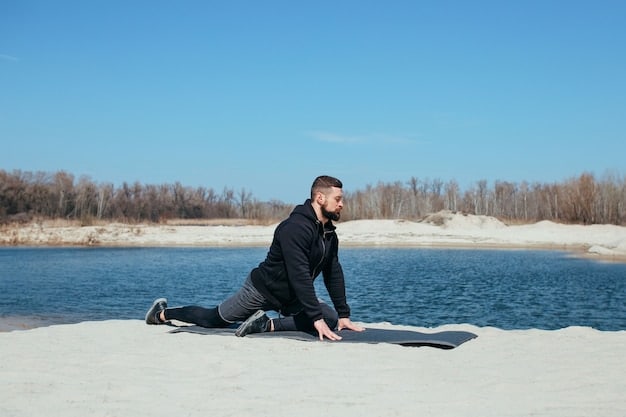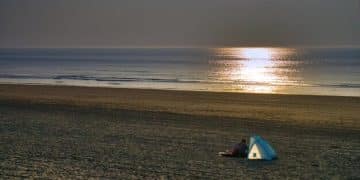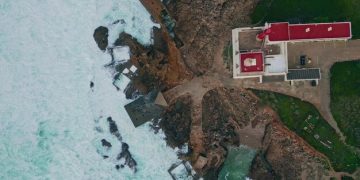Beach Workout Routine: Full-Body Sand Exercises

Engaging in a beach workout routine offers a unique, challenging, and highly effective way to achieve a full-body burn, utilizing the natural resistance and instability of sand to amplify exercise benefits and cardiovascular intensity.
Transforming your beach getaway into an invigorating fitness opportunity is easier and more effective than you might think. A beach workout routine: exercises you can do in the sand for a full-body burn offers a dynamic approach to fitness, leveraging the natural environment to supercharge your efforts. Beyond the picturesque backdrop, the inherent instability of sand elevates classic movements, turning a casual stroll into a muscle-engaging endeavor and a simple push-up into a core-stabilizing challenge. This unique training ground provides both resistance and cushioning, making it ideal for a comprehensive workout that’s both demanding and lower impact on your joints than harder surfaces.
Why Sand Makes the Perfect Workout Ground
Exercising on sand isn’t just a beautiful setting; it’s a biomechanical advantage. The yielding nature of sand forces your muscles to work harder, engaging stabilizer muscles that might otherwise remain dormant on firmer ground. This increased muscle activation translates to a higher caloric burn and enhanced strength development across your entire body.
The soft surface also provides a natural cushion, significantly reducing the impact on your joints compared to pavement or traditional gym floors. This makes beach workouts a fantastic option for individuals seeking a high-intensity session with less wear and tear on knees, ankles, and hips. Think about the difference between running on concrete versus running on a trail. Sand amplifies that protective effect while dramatically increasing the intensity of your movements.
Enhanced Muscle Engagement
When you perform exercises on an unstable surface like sand, your body has to continuously make tiny adjustments to maintain balance. This constant micro-adjustment activates a wider range of muscles, particularly those in your core and lower body, that are crucial for stability and overall functional strength.
- Glutes and Hamstrings: Every step and jump on sand requires more effort from these powerful leg muscles.
- Calves and Ankles: The uneven terrain strengthens the small muscles and ligaments around your lower legs, preventing injuries.
- Core Muscles: From planks to squats, your core works overtime to keep your body stable and aligned.
Increased Caloric Expenditure
The extra effort required to push off and stabilize on sand means you’re burning more calories in less time. Studies have shown that running on sand can burn up to 1.6 times more calories than running on a hard surface. This principle applies to all exercises, making beach workouts incredibly efficient for weight management and fitness goals.
Imagine the energy output needed for a simple lunge. On sand, your body sinks slightly, demanding more power to lift and stabilize. This resistance creates a more intense workout from familiar movements, accelerating your results and pushing your cardiovascular limits in a refreshing outdoor environment.
Pre-Workout Beach Preparation Essentials
Before diving into your sandy sweat session, a little preparation goes a long way. Ensuring you’re properly equipped and hydrated can make the difference between a great workout and a uncomfortable one. The beach environment has its unique demands, and being mindful of them will enhance your experience and safety.
Sun protection, hydration, and appropriate footwear (or lack thereof) are paramount. The sun’s intensity can be amplified by reflective sand and water, making sunburn and dehydration significant risks. Taking the time to prepare allows you to fully immerse yourself in the workout without worrying about preventable issues.
Hydration and Sun Protection
Staying hydrated is crucial, especially when exercising outdoors under the sun. Always bring a large water bottle and sip frequently, even before you feel thirsty. Dehydration can quickly sap your energy and lead to heat exhaustion.
- Water: Bring at least 20-30 ounces of water for a typical 30-60 minute workout.
- Sunscreen: Apply a broad-spectrum, water-resistant sunscreen with at least SPF 30 generously to all exposed skin.
- Headwear: A wide-brimmed hat or cap can protect your face and scalp from direct sun.
Footwear Considerations
One of the beauties of beach workouts is the option to go barefoot, which can strengthen the small muscles in your feet and ankles. However, be mindful of potential hazards. Walking and running barefoot builds strength, but sudden changes in terrain or encountering sharp objects can cause injury.
If you choose to wear shoes, opt for minimal athletic footwear that drains well and can handle sand. Running shoes designed for trails might offer a good compromise between protection and flexibility. Conversely, some people prefer the full sensory experience of barefoot training, provided the sand is clean and free of debris.

Dynamic Warm-Up: Preparing Your Body for Sand Training
A proper warm-up is essential for any workout, but particularly so for beach training where your muscles will be working overtime to stabilize. A dynamic warm-up increases blood flow, enhances flexibility, and prepares your joints and muscles for the demanding movements ahead. It’s about moving through a range of motions, not static stretching.
Start gently and progressively increase your intensity. This warm-up should take about 5-10 minutes and involve full-body movements. The goal is to elevate your heart rate slightly and get your muscles warm and pliable, ready for the unique challenges that exercising on sand presents.
Light Cardio and Mobility Drills
Begin with a few minutes of light cardio to get your heart rate up and blood flowing. This can be as simple as jogging along the waterline or performing jumping jacks.
Follow with mobility drills that target major muscle groups and joints:
- Arm Circles: Forward and backward to warm up shoulders.
- Leg Swings: Forward and sideways to stretch hips and hamstrings.
- Torso Twists: Gentle rotations to warm up the spine and core.
Active Stretching
Unlike static stretches, active stretches involve movement through a range of motion. These prepare your muscles for the dynamic bursts required on sand.
Incorporate movements like:
- Walking Lunges: Step forward into a lunge, bringing the back knee close to the sand.
- High Knees: Marching or light jogging, bringing knees high towards your chest.
- Butt Kicks: Light jogging while trying to kick your glutes with your heels.
Full-Body Sand Exercises: The Core Routine
This section outlines a comprehensive beach workout routine, blending classic exercises with sand-specific modifications to ensure a full-body burn. Each exercise benefits from the sandy environment, amplifying its effectiveness. Focus on form over speed, especially when new to sand training, as the instability can challenge your balance.
Remember that the sand’s resistance is your friend. It provides an ever-present challenge, making even simple movements more effective. Aim for 3-4 sets of 10-15 repetitions for strength exercises, and 30-60 seconds for cardio-based movements. Adjust as needed to your fitness level. This routine is designed for maximum engagement and efficiency.
Lower Body Power: Squats, Lunges, and Jumps
The lower body benefits immensely from sand training. Squats, lunges, and jumps demand more power and control, leading to stronger glutes, quads, and hamstrings.
- Sand Squats: Stand with feet shoulder-width apart. Lower your hips as if sitting in a chair, pushing through your heels with the added resistance of sand.
- Beach Lunges: Step forward into a lunge, ensuring your front knee doesn’t go past your toes. The sand will challenge your balance.
- Broad Jumps: Explode forward, jumping as far as you can from a squat position. Land softly and absorb the impact with bent knees, allowing the sand to cushion your landing.
Upper Body Strength: Push-ups, Planks, and Bear Crawls
Even though the lower body feels the most burn on sand, your upper body and core will also work hard to maintain stability. Sand makes traditional upper body exercises more challenging by creating an unstable base.
Try placing your hands or forearms directly on the sand for an added grip and stability test. This engages smaller supporting muscles in your shoulders and arms, enhancing overall upper body resilience. The shifting sand means your muscles are constantly adapting, leading to greater strength and endurance.
- Sand Push-ups: Perform standard push-ups with your hands on the sand. The unstable surface will make you work harder to stabilize your core and shoulders.
- Forearm Plank on Sand: Hold a plank position on your forearms. Your core will be highly engaged to prevent your body from sinking or swaying in the sand.
- Bear Crawls: Crawl forward on all fours, keeping your hips low. This full-body movement builds shoulder stability, core strength, and coordination.
Core Engagement: Crunches, Bicycle Kicks, and Leg Raises
A strong core is the foundation of all movement, and sand training significantly enhances core strength by demanding constant stabilization. The soft, uneven surface forces your abdominal and oblique muscles to work overtime to keep your body still and balanced, boosting the effectiveness of traditional core exercises.
Every movement engages your core to some degree, but specific exercises directly target these crucial muscles. On the sand, the subtle shifts amplify the challenge, preventing your body from relying solely on momentum and requiring precise, controlled movements that build deeper core strength.
- Sand Crunches: Lie on your back, knees bent, feet on the sand. Perform standard crunches, focusing on contracting your abs.
- Bicycle Kicks: Lie on your back, bringing opposite elbow to knee. The sand provides a grounded but slightly shifting base, intensifying the core engagement.
- Leg Raises: Lie on your back, keeping legs straight. Slowly raise and lower your legs, focusing on controlled movement. The sand prevents you from cheating by using momentum.
Functional Movements and Cardio Integration
Integrating functional movements and cardiovascular elements into your beach workout is key to achieving a truly full-body burn. These exercises mimic natural human movements and elevate your heart rate, providing a comprehensive fitness experience. The sand amplifies the effort, making them incredibly effective for improving endurance, agility, and overall conditioning.
Functional training focuses on movements that prepare your body for real-life activities, while cardio burns fat and improves cardiovascular health. Combining these on the beach creates a dynamic, challenging session that enhances athletic performance and daily well-being. Think about movements that require quick changes in direction or bursts of energy.
Agility Drills: Shuttles and Lateral Hops
Agility drills are fantastic for improving your quickness, coordination, and ability to change direction. The sand adds a layer of difficulty, making these drills exceptionally effective.
- Shuttle Runs: Mark two points about 10-20 yards apart. Sprint between them, touching the sand at each end.
- Lateral Hops: Stand with feet together. Hop sideways over an imaginary line, focusing on quick, explosive movements.
Cardiovascular Burn: Sprints and High-Knee Running
Nothing gets your heart pumping like sprints, and doing them on sand amplifies the caloric burn and muscle engagement. The resistance forces your body to work harder, improving speed and explosive power.
Remember to maintain good form, even as fatigue sets in. Lean slightly forward, pump your arms, and focus on powerful strides. These exercises are excellent for building endurance and pushing your anaerobic limits, yielding significant fitness gains.
- Beach Sprints: Sprint for 30-60 yards, walking back slowly to recover. Repeat several times.
- High-Knee Running: Jog in place or forward, bringing your knees as high as possible with each step.
Post-Workout Cool-Down and Recovery
Just as important as the warm-up, a proper cool-down and stretching routine helps your body recover, reduces muscle soreness, and improves flexibility. On the beach, the natural environment can enhance this process, providing a calming backdrop for your recovery.
Don’t skip this crucial phase. Cooling down gradually brings your heart rate back to normal, and stretching helps to lengthen muscles that have contracted during your workout. Take advantage of the peaceful beach setting to fully wind down both your body and mind after your intense session.
Static Stretching on the Sand
After your workout, perform static stretches, holding each stretch for 20-30 seconds. Focus on the muscles you’ve just worked intensely.
- Quad Stretch: Stand on one leg (or use a wall for balance) and pull your heel towards your glute.
- Hamstring Stretch: Sit on the sand with legs extended, reach for your toes.
- Calf Stretch: Lean against a firm surface (like a boardwalk or dune) and push your heel down.
Mindful Breathing and Hydration
As you stretch, focus on deep, controlled breathing. This aids in muscle relaxation and promotes overall recovery. Inhale deeply through your nose, and exhale slowly through your mouth. This also helps to calm your nervous system.

Continue to rehydrate after your workout. Replacing lost fluids is crucial for muscle repair and overall well-being. Consider adding electrolytes if you’ve had a particularly intense or long session, or if the weather was very hot. Electrolytes help restore the mineral balance lost through sweat, aiding in quicker and more effective recovery.
Optimizing Your Beach Workout Schedule
Establishing a consistent routine is paramount for sustainable fitness gains, and a beach workout schedule is no exception. Planning your sessions around the tides and sun’s intensity can significantly enhance your experience and safety. Early mornings or late afternoons often offer the best conditions: cooler temperatures, gentler sun, and potentially fewer crowds. This ideal timing allows you to exert maximum effort without the risks associated with heat exhaustion. Also, consider the tide; low tide often provides a wider, firmer expanse of sand, which can be more amenable to certain exercises, while high tide might offer softer, more challenging terrain for others.
Varying your routine not only prevents boredom but also challenges different muscle groups, leading to more balanced development and reducing the risk of overuse injuries. Integrating various exercises and intensities keeps your body adapting and your motivation high. Listen to your body and adjust the frequency and intensity of your workouts based on how you feel. Consistency, combined with smart scheduling and variety, is the recipe for long-term success in your beach fitness journey.
Frequency and Duration
For most individuals, aiming for 3-4 beach workouts per week is ideal. Each session can range from 30 minutes to an hour, depending on your fitness level and available time. This frequency allows for adequate rest and recovery between sessions, which is crucial for muscle repair and growth, especially given the increased demands of sand training.
- Beginners: Start with 2-3 sessions, 30 minutes each, focusing on proper form.
- Intermediate/Advanced: 3-4 sessions, 45-60 minutes, incorporating higher intensity and varied exercises.
- Rest Days: Crucial for recovery. Include active recovery like light walks on the beach.
Integrating with Other Training
Beach workouts can complement your existing fitness regimen, not replace it entirely. They are excellent for specific benefits like enhanced muscle engagement and joint protection, but other environments offer their own unique advantages. For example, lifting heavy weights in a gym provides progressive overload crucial for maximal strength, while swimming in the ocean offers a full-body, low-impact cardio challenge. Incorporating a mix ensures a well-rounded fitness approach.
Consider varying your workouts throughout the week. You might do a beach workout on one day, indoor strength training on another, and perhaps a cross-training activity like cycling or a yoga session. This varied approach keeps your body guessing, avoids plateaus, and ensures you’re developing all aspects of your physical fitness, from strength and endurance to flexibility and balance, maximizing your overall health benefits.
| Key Aspect | Brief Description |
|---|---|
| 💪 Muscle Burn | Sand’s instability forces muscles to work harder for stabilization, increasing calorie burn. |
| 🛡️ Joint Protection | Soft sand reduces impact on joints, ideal for high-intensity workouts. |
| 💧 Hydration & Safety | Essential to drink plenty of water and use sunscreen due to sun exposure. |
| 🗓️ Optimal Scheduling | Morning/late afternoon workouts avoid peak sun; consider tides for firmer sand. |
Frequently Asked Questions
▼
Yes, running on sand is significantly harder than running on pavement. The unstable and yielding nature of sand forces your muscles to work much harder to propel you forward and maintain stability. This increased effort leads to higher calorie expenditure and enhances muscle engagement, especially in the calves, hamstrings, and glutes, making it a more intense workout.
▼
Exercising barefoot on the beach can strengthen the small intrinsic muscles of your feet and ankles, improving balance and proprioception. It also allows for a greater range of motion in the ankles and a more natural foot strike. However, caution is advised to avoid sharp objects or uneven patches that could lead to injury. Always check the sand first.
▼
Beyond running, the beach is excellent for a variety of exercises. You can perform bodyweight strength training like squats, lunges, push-ups, and planks, which are amplified by sand’s instability. Agility drills, bear crawls, and various core exercises like crunches and bicycle kicks also become more challenging and effective on the soft, shifting surface.
▼
The frequency depends on your fitness level and goals. For beginners, 2-3 sessions per week, each lasting 30-45 minutes, is a good starting point. More advanced individuals can aim for 3-4 sessions of 45-60 minutes. It’s crucial to allow for rest days to ensure proper muscle recovery, especially since sand workouts are more demanding.
▼
Essentials for a beach workout include a large water bottle for hydration, broad-spectrum sunscreen, and a hat or sunglasses for sun protection. You might also want a towel to lie on for ground exercises. Footwear is optional, depending on personal preference and the beach’s terrain, but check for any debris if going barefoot.
Conclusion
Embracing a beach workout routine is an intelligent and refreshing way to supercharge your fitness goals, transforming an idyllic setting into a formidable gym. The natural resistance and instability of sand provide an unparalleled challenge, enhancing muscle engagement, boosting calorie burn, and offering a lower-impact alternative to traditional surfaces. From dynamic sprints to core-strengthening planks, every movement benefits from the unique environment, promising a genuinely invigorating full-body burn. By prioritizing proper preparation, conscious form, and adequate recovery, you can harness the power of the beach to forge a stronger, more resilient physique, making your fitness journey both effective and incredibly enjoyable. So, next time you’re by the ocean, let the sand be your ultimate fitness partner.
Total word count: 2062





